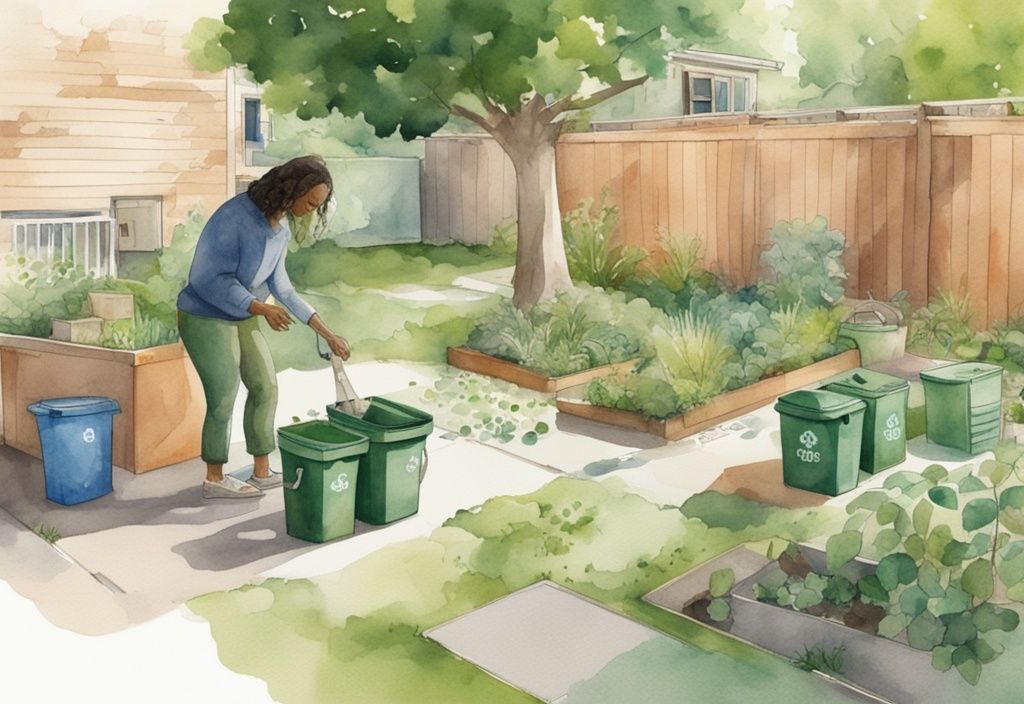Efficient Ways on How to Help the Environment: Make a Difference
Did you know that a few simple changes in your lifestyle could significantly benefit our planet? It’s true. As a firm believer in eco-friendly living, I often muse on how everyday choices, from what we eat to what we purchase, don’t just shape us but also our world. This guide will demonstrate just that.
Among these digital pages, you’ll find a trove of practical tips – small, yet impactful changes that contribute to environmental preservation. Imagine, with every eco-conscious decision, you’ll be helping combat climate change, promoting biodiversity, and paving the way to a sustainable future.
I warmly invite you on this journey of discovery, to delve into the myriad of ways our individual actions can help knit a greener, healthier planet. Ready to make a difference? Let’s get started!
Why Environmental Protection Matters: Setting the Scene
Humans need to adopt cleaner living habits to protect the environment and preserve the planet for future generations. Our planet’s health is intricately tied to our behaviors, especially around consumption. The way we consume – what, how much, and how often – has a direct impact on the environment, leading to pollution, resource depletion, and ecological imbalance.
Environmental damage largely stems from consumption. Every product we buy, from groceries to gadgets, has an ecological footprint. Excessive consumption, often driven by a culture of disposability, leads to higher waste, greater resource extraction, and significant energy use. By understanding how consumption affects the environment, we can make more deliberate choices that mitigate damage.
Being mindful of consumption habits and understanding their environmental impact is crucial. Awareness is the first step towards change. When we recognize the consequences of our consumption, we can adjust our behaviors to align with sustainable practices. This involves choosing products that are environmentally friendly, made from sustainable materials, and have a lower carbon footprint.
Small individual changes, if widely adopted, can significantly improve the planet’s health. Simple practices like reducing waste, conserving energy, and selecting eco-friendly products can add up when adopted collectively. These adjustments may seem minor on an individual level, but collectively, they can drive substantial environmental recovery and sustainability.
Everyone has a role to play in addressing environmental issues such as climate change, land degradation, and loss of biodiversity. Whether through daily habits or larger lifestyle changes, each person’s contribution is vital.
Addressing these issues requires a concerted effort from all sectors of society, including governments, businesses, and individuals.
Everyday choices and purchases impact the environment and biodiversity, even in ways you might not immediately realize. From the food we eat to the clothes we wear, every decision has an environmental cost. Choosing sustainable options, reducing waste, and supporting ethical brands are practical steps to lessen our ecological impact and support biodiversity.
Taking these steps involves understanding how we can help the environment through deliberate action and mindfulness. By focusing on sustainable consumption and making environmentally conscious choices, we can collectively drive meaningful change and ensure a healthier planet for future generations.
—
Why Environmental Protection Matters: Setting the Scene
In today’s world, our actions significantly impact the environment, creating both challenges and opportunities for us to help the environment. One of the critical areas where we can make a difference is through our consumption habits. In this section, we’ll explore the intricate relationship between consumption, environmental damage, and how we can shift towards more sustainable practices.
Humans need to adopt cleaner living habits to protect the environment and preserve the planet for future generations. Our planet’s health is intricately tied to our behaviors, especially around consumption. The way we consume – what, how much, and how often – has a direct impact on the environment. This leads to pollution, resource depletion, and ecological imbalance.
Consider every product you buy, from groceries to gadgets. Each item has an ecological footprint. Excessive consumption, often driven by a culture of disposability, leads to higher waste, greater resource extraction, and significant energy use. By understanding how our consumption affects the environment, we can make deliberate choices that mitigate damage.
Being mindful of consumption habits and understanding their impact is crucial to helping the environment. Awareness is the first step towards change. When we recognize the consequences of our consumption, we can adjust our behaviors to align with sustainable practices. This involves choosing products that are environmentally friendly, made from sustainable materials, and have a lower carbon footprint.
Consider the small individual changes you can make. Simple practices like reducing waste, conserving energy, and selecting eco-friendly products can significantly improve the planet’s health when adopted widely. These adjustments may seem minor individually, but collectively, they can drive substantial environmental recovery and sustainability.
Each of us has a role to play in addressing environmental issues such as climate change, land degradation, and loss of biodiversity. Whether through daily habits or larger lifestyle changes, every person’s contribution is vital. Addressing these issues requires a concerted effort from all sectors of society, including governments, businesses, and individuals.
Recognize that everyday choices and purchases impact the environment, often in ways you might not immediately realize. From the food you eat to the clothes you wear, every decision has an environmental cost. Choosing sustainable options, reducing waste, and supporting ethical brands are practical steps to lessen our ecological impact and support biodiversity.
Understanding how to help the environment involves deliberate action and mindfulness. By focusing on sustainable consumption and making environmentally conscious choices, we can collectively drive meaningful change and ensure a healthier planet for future generations. Let’s take these steps together for a sustainable future.

Consumption Habits: Effective Strategies to Aid Sustainability
Discover how making mindful choices in your daily consumption can significantly help the environment.
The 4 R’s of Sustainability: Refuse, Reduce, Recycle, and Reuse
Adopting the 4 R’s of sustainability has profoundly reshaped my understanding of how to help the environment. Refuse non-essential items that generate waste, clutter, and squander resources. By simply saying no, you can reduce waste at the very source.
Choosing to Reduce consumption involves selecting durable, high-quality products that last longer and steering clear of items with excessive packaging. This approach not only minimizes waste but fosters a more thoughtful consumption pattern.
Recycle rigorously by familiarizing yourself with local recycling guidelines and understanding the recycling process. Enlightening myself about what can and cannot be recycled has made a vast difference in conserving energy and resources. Recycling cuts down on new material production and waste.
Finally, embracing the art of Reusing by repurposing everyday items is both fun and impactful. Extending the life of products through creative reuse curtails the demand for new items and reduces overall waste, making a significant contribution to environmental sustainability.
Secondhand Shopping and its Benefits to Our Planet
Opting for secondhand shopping is one of my favorite ways of how to help the environment. The production process for new clothing consumes vast resources, especially water and energy. By buying secondhand or swapping clothing, you’re promoting resource conservation and reducing the demand for new products.
Fast fashion concerns me deeply because it promotes quick production and disposal, resulting in enormous waste and pollution. By choosing sustainable fashion options, like purchasing less and selecting higher-quality items, you can diminish your environmental impact.
Adopting a conscious shopping approach supports a shift towards a more sustainable and eco-friendly fashion industry. Making these changes might seem small, but collectively, they have a big impact on the planet.
Choosing Locally-Sourced and Sustainable Products
Opting for locally-sourced and sustainable products is another cornerstone of how to help the environment. Shopping locally minimizes the packaging waste often associated with online purchases and cuts down on fuel consumption required for long-distance shipping.
Choosing products made from natural, organic, and chemical-free ingredients helps to reduce the release of harmful substances into the environment. This decision alone not only contributes to a healthier planet but also bolsters local economies and sustainable practices.
By integrating these eco-conscious choices into your daily life, you help preserve natural resources and promote a more sustainable lifestyle. Each mindful decision you make inches the world closer to environmental wellness.
Practical Everyday Habits: Making Sustainable Choices
This segment delves into actionable steps that you can incorporate into your daily routine to make a significant impact on the environment. Simple changes can lead to big results when it comes to living sustainably. From switching out single-use items to composting and conserving water, each choice adds up.
Smart Switches: Replacing Single-Use Items
One of the simplest and most effective ways on how to help the environment is by replacing single-use items with reusable alternatives. I remember the day I swapped my disposable coffee cup for a chic, reusable one—it felt like such an easy change, but it made a big difference! Investing in reusable cups, bottles, bags, plates, and utensils can significantly reduce the amount of plastic waste you generate daily. These items are typically more durable and can be used repeatedly, cutting down on the need to constantly purchase disposable products. By making these smart switches, you are reducing the demand for single-use plastics, which often end up polluting our land and oceans.
Composting: Turning Waste into a Resource
Starting a compost bin is an excellent way to minimize food and yard waste while contributing to a healthier environment. I found that composting my organic kitchen scraps and yard trimmings was a satisfying way to see waste turn into something valuable. Composting involves collecting organic waste, such as fruit and vegetable scraps, coffee grounds, and yard trimmings, and allowing them to decompose naturally. The result is nutrient-rich compost that can be used to enrich garden soil, reducing the need for chemical fertilizers. By composting, you not only lessen the volume of waste sent to landfills but also create a valuable resource for your garden.
Water Conservation: Easy Tips to Save More
Conserving water is a crucial step in how to help the environment. Simple habits, such as turning off taps when not in use, fixing leaks promptly, and installing water-efficient fixtures, can make a big difference. Collecting rainwater for plant irrigation and taking shorter showers are other effective strategies. These easy-to-implement practices help conserve this vital resource, lower utility bills, and reduce the strain on municipal water systems.
Energy Efficiency: Simple Ways to Lessen Your Carbon Footprint
Improving energy efficiency is key in reducing your carbon footprint. Switch to energy-efficient lighting, like LED bulbs, which use less energy and last longer. I’ve found that using smart power strips to manage multiple devices really helps keep our energy consumption in check. Unplug electronics and chargers when they’re not in use. Opt for rechargeable batteries instead of disposable ones to minimize pollution and save money over time. Additionally, sealing air leaks, proper insulation, and using ceiling fans can help maintain comfortable indoor temperatures, reducing the need for extensive heating and cooling. Adopting these practices helps decrease greenhouse gas emissions and promotes a more sustainable lifestyle.
Transportation Choices that Benefit the Environment
Walking and biking are wonderful ways to help the environment by reducing vehicle emissions. These modes of transport not only cut down on harmful gases but also promote personal health. By choosing to walk or bike for short distances, you can significantly lower your carbon footprint.

For longer distances, consider combining errands into one trip to reduce the number of journeys you need to make. Sustainable transportation options like these are simple shifts with substantial benefits, making it easier to integrate eco-friendly solutions into everyday life.
Public Transportation and Carpooling: Cut Down Your Carbon Emissions
Using public transportation and carpooling are practical strategies to decrease your carbon emissions. Public transportation systems, such as buses, trains, and subways, are designed to carry large numbers of passengers, thereby reducing the total fuel consumption per person.
Carpooling offers similar advantages by sharing rides to common destinations. These practices not only cut down individual fuel consumption but also help to alleviate traffic congestion, creating a more efficient transportation system. For those curious about the environmental impact of different products, you might want to explore whether Keurig coffee is bad for you.
By opting for these eco-friendly methods, you contribute to a sustainable lifestyle and actively participate in how to help the environment.
Eat Green: How Your Food Choices Can Help the Planet
Eating Less Meat: An Easy Step Towards a Healthier Planet
Reducing animal product consumption is pivotal in understanding how to help the environment. Animal agriculture significantly contributes to greenhouse gas emissions, deforestation, and inefficient land use. By incorporating more plant-based meals into your diet, you can decrease your environmental footprint. Cutting down meat not only benefits the planet but aligns with the growing movement towards sustainable living. Embracing vegetarian or vegan options can profoundly reduce the resources needed for food production, thereby helping to mitigate climate change and promote biodiversity.
Through personal experience, I have noticed the positive impact of even small dietary changes. When I shifted to plant-based meals, the change felt more significant knowing it helped the environment. Imagine the collective impact if we all took this step, even gradually. It’s simpler than it seems and can be delicious too. For those wondering, you might ask, does native shampoo cause dandruff?
Why Opt for Locally-Sourced and Organic Foods
Selecting locally-sourced and organic foods is another effective strategy on how to help the environment. Locally-sourced foods minimize the carbon footprint linked with long-distance transportation. They require fewer fuel resources and generate less packaging waste. Organic farming practices avoid harmful chemicals, preserving soil health and water quality while supporting sustainable agriculture.
Growing your own food or buying from local farmers strengthens community ties and ensures access to fresh, seasonal produce. Supporting local and organic food options is a tangible way to encourage environmentally friendly practices. It benefits both the ecosystem and society.
I’ve discovered that not only is the food fresher when sourced locally, but it also feels rewarding knowing my choices support my community and the environment. These small steps can initiate a ripple effect, fostering a sustainable lifestyle that benefits us all.
Create an Eco-Friendly Home and Garden
How to Use Renewable Energy in Your Home
Switching to renewable energy sources like solar or wind power can be one of the most impactful steps du can take to help the environment. I remember installing solar panels on my rooftop; it significantly reduced my reliance on fossil fuels. This not only cut down on air pollution and greenhouse gas emissions but also lowered my energy bills. Wind turbines, though less common for residential use, can be an excellent choice if dein home is in a breezy area.
These renewable energy systems are a win-win; they decrease environmental harm while offering financial benefits. Plus, several government incentives and tax credits make installing these systems more affordable and appealing. It’s a worthwhile investment in our planet’s future.
Energy-Saving Home Improvements You Need to Consider
Simple upgrades in your home can greatly reduce energy consumption and greenhouse gas emissions. One easy step is switching off lights and unplugging electronics when du aren’t using them. I started using energy-efficient light bulbs, like LEDs, and noticed they use significantly less power and last much longer than traditional incandescent bulbs. This switch contributed to lower electricity bills and reduced waste.
Another change I made was sealing air leaks around windows and doors and ensuring proper insulation. This helped maintain my home’s temperature, making the heating and cooling systems work less, thus conserving energy. Installing smart thermostats and power strips further optimized my energy use, making my home not just eco-friendly but also economically efficient.
Non-Toxic Gardening: Native Plants and Pollinator Gardens
Choosing native plant species for your garden can dramatically cut down on water usage and support local wildlife, which is crucial in how to help the environment. Native plants are well-adapted to the local climate and soil, requiring less water, fertilizers, and pesticides. This conserves water resources and reduces chemical runoff into local ecosystems.
When I started incorporating pollinator-friendly plants like wildflowers and herbs, my garden transformed into a thriving habitat for bees, butterflies, and other beneficial insects. Avoiding chemical pesticides and fertilizers was another key change. Instead, I opted for natural alternatives like compost and organic pest control methods. This kept my garden healthy and vibrant without harming the environment.
By embracing these eco-friendly practices, du can create a home and garden that not only nurtures your well-being but also contributes to the health of our planet.
Inspiring Others Towards Environmental Protection
One of the most impactful ways to help the environment is by inspiring others and fostering a collective movement towards sustainability. This section explores different strategies to spread environmental awareness effectively and encourages political engagement for substantial change.
How to Spread Environmental Awareness Effectively
To genuinely influence how others perceive and act towards the environment, it’s crucial to utilize your voice thoughtfully. Start by educating yourself about environmental issues so you can speak confidently and knowledgeably when engaging with leaders and advocating for change. Participate in community forums, town hall meetings, and social media discussions where environmental topics are discussed.

Encouraging friends, neighbors, and colleagues to take positive actions can create a ripple effect, amplifying the impact. Share relatable stories and tangible benefits of sustainable living to make the concepts more accessible. Leading by example is another powerful tool. By making sustainable choices in your daily life and discussing them openly, you can inspire others to follow suit. Highlight your experiences, successes, and even the challenges you face to provide a realistic perspective that empowers others to adopt similar habits.
Getting Involved in Environmental Policy Discourses
Political engagement is a critical avenue for driving significant environmental change. Start by researching and voting for representatives who prioritize environmental sustainability. Hold these leaders accountable by actively engaging with them through letters, emails, and social media. Attend town hall meetings and other public forums to voice your concerns and suggestions directly.
Local governance offers another impactful platform. Contact local officials to discuss pressing environmental issues in your area and propose practical solutions. Volunteering with local environmental groups not only amplifies your efforts but also fosters a community of like-minded individuals committed to making positive change. These activities not only show how to help the environment but also embed these values within your local framework, creating a broader, more robust movement towards sustainability.
By employing these strategies, you not only contribute positively but also inspire others, creating a sustainable future for generations to come.
Conclusion: Your Role in Making Every Action Count
The journey towards a healthier planet begins with individual decisions, and small lifestyle changes can collectively make a significant impact on how to help the environment. Making sustainable choices is not only a responsibility but a necessity to safeguard our future.
Start with Small, Achievable Steps
Commit to simple daily habits like reducing single-use plastics, conserving water, and minimizing energy consumption. Each of these actions contributes to reducing the overall carbon footprint and helps in protecting natural resources.
Champion the 4 R’s
Integrate the principles of Refuse, Reduce, Recycle, and Reuse into your everyday life. Refuse non-essential items, reduce consumption, ensure proper recycling, and find creative ways to reuse products. These steps can drastically reduce waste and environmental degradation.
Support Local and Sustainable Products
Choosing locally-sourced and sustainable alternatives can drastically reduce environmental impact. Opt for products that are natural, organic, and chemical-free to avoid harm to ecosystems. Support local farmers and artisans to boost eco-friendly practices in your community.
Adopt Sustainable Transportation
Reduce reliance on personal vehicles by adopting walking, biking, carpooling, and using public transportation. These choices minimize carbon emissions and foster a greener environment, providing cleaner air and reducing traffic congestion.
Promote Awareness and Community Engagement
Be an advocate for environmental protection by educating friends, family, and coworkers on sustainable practices. Participate in local environmental initiatives and policy discussions. Your role as an informed individual can inspire broader changes and community efforts.
Invest in Energy Efficiency
Make your home energy-efficient by using energy-saving appliances, fixing leaks, and insulating properly. Transition to renewable energy sources like solar or wind power, which lessen dependence on fossil fuels and reduce greenhouse gas emissions.
Be Mindful of Food Choices
Eating less meat and choosing locally-sourced, organic food not only supports sustainable farming but also reduces the carbon footprint. Grow your own produce to further minimize environmental impact and promote healthier eating habits.
The urgency to act is undeniable, and each effort counts. By committing to these changes now and cultivating sustainable habits, we all play a part in ensuring a thriving planet for future generations.
FAQs: Answers to Common Queries About Helping the Environment
What’s the most impactful way to help the environment?
One powerful approach to help the environment is by reducing animal product consumption. Switching to renewable energy sources and actively reducing waste through recycling efforts are also effective methods. These steps create a significant positive impact on our planet.
How to reduce my carbon footprint in a simple way?
There are many simple ways to reduce your carbon footprint. Start by using public transportation, carpooling, biking, or walking instead of driving. Another effective method is switching to energy-efficient lighting and appliances. Additionally, conserving water and energy through mindful usage habits makes a big difference too.
What eco-friendly alternatives exist for everyday products?
Opting for eco-friendly alternatives can greatly reduce your environmental impact. Consider using reusable water bottles, containers, and bags. Natural and organic household cleaning products and personal hygiene items are also excellent choices for minimizing harm to the environment.
How can I engage in local environmental endeavors?
Engaging in local environmental initiatives fosters community and supports larger environmental goals. Volunteer with local environmental groups or participate in community cleanups and events. Supporting local conservation programs is another way to contribute positively.
What should I steer clear of to lessen environmental harm?
Avoiding certain products can significantly lessen environmental harm. Steer clear of single-use plastics and items with excessive packaging. Opt for sustainable alternatives to fast fashion, and limit products that contain harmful chemicals or non-renewable resources. These choices promote a healthier planet and lifestyle.
Hi, I’m Olivia Green, the voice behind nontoxicways.com. I’m passionate about helping you make the shift to a healthier, non-toxic lifestyle without feeling overwhelmed. I love sharing my personal journey, from small changes to big transformations, along with practical tips that make it all feel doable. My goal is to inspire and guide you toward a lifestyle that benefits both your well-being and the planet. Let’s take this journey together, one simple step at a time!














Post Comment